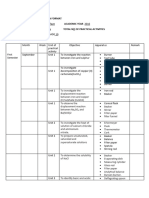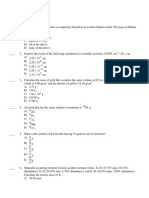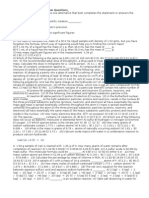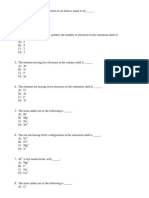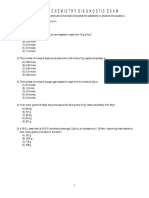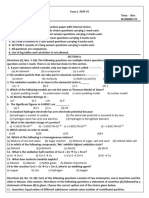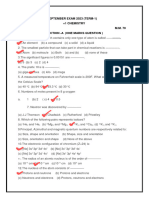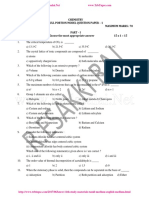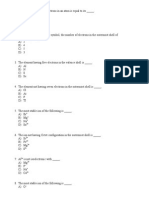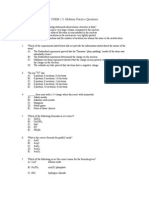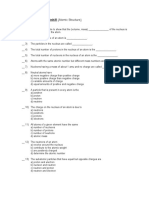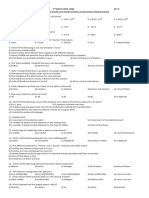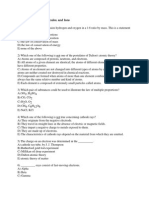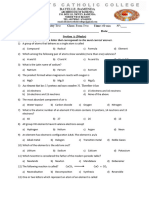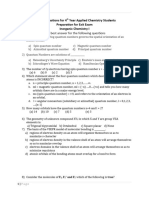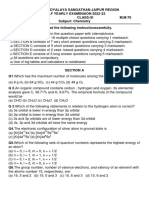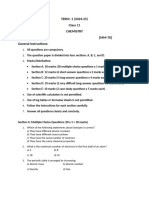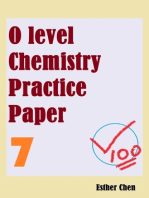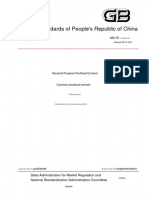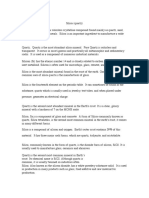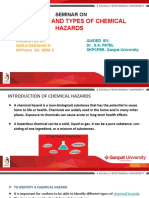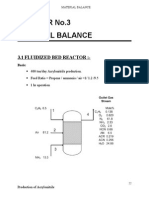Chemistry 110 2nd Midterm Review 3
Chemistry 110 2nd Midterm Review 3
Uploaded by
8pvbd9ssxbCopyright:
Available Formats
Chemistry 110 2nd Midterm Review 3
Chemistry 110 2nd Midterm Review 3
Uploaded by
8pvbd9ssxbCopyright
Available Formats
Share this document
Did you find this document useful?
Is this content inappropriate?
Copyright:
Available Formats
Chemistry 110 2nd Midterm Review 3
Chemistry 110 2nd Midterm Review 3
Uploaded by
8pvbd9ssxbCopyright:
Available Formats
Chemistry 110 2nd Midterm Review (New Syllabus) By Mr Chemistry!
1. The symbol e is a symbol used for a(n) ________.
A) proton
B) neutron
C) gamma ray
D) beta particle
E) alpha particle
2. A positron is a particle emitted from the nucleus that has the same mass as
a(n) ________.
A) electron but has a positive charge
B) neutron but has a positive charge
C) alpha particle
D) beta particle
E) proton emitted from the nucleus
3. Radium-226 decays by alpha emission to ________.
A) barium-131
B) cobalt-60
C) carbon-14
D) polonium-218
E) radon-222
Copyright @Classatk @NasserNHasan +965 6595 9989 1
4. In the nuclear equation of beta decay, ________.
A) the new nucleus contains 2 fewer protons
B) the new nucleus contains 2 more protons
C) the mass number of the new nucleus is 4 less than that of the original
nucleus
D) the new nucleus contains 1 more proton
E) the new nucleus contains 1 less proton
5. What is the radioactive particle released in the following nuclear equation?
Sr → Y+?
A) alpha particle
B) beta particle
C) positron
D) proton
E) neutron
Copyright @Classatk @NasserNHasan +965 6595 9989 2
6. The nuclear symbol that completes the equation is a(n) ________.
Am + ? → Bk + n
A) proton
B) neutron
C) gamma ray
D) beta particle
E) alpha particle
7. A patient receives 4 × 103 mrad of iodine-131, which emits β-particles. If the
factor that adjusts for biological damage is 1 for β-particles, how many rems
did the patient receive?
A) 4
B) 0.4
C) 0.3
D) 2
E) 40
Copyright @Classatk @NasserNHasan +965 6595 9989 3
8. The half-life of a radioisotope is ________.
A) one-half of the time it takes for the radioisotope to completely decay to a
nonradioactive isotope
B) the time it takes for the radioisotope to become an isotope with one-half
of the atomic weight of the original radioisotope
C) the time it takes for the radioisotope to become an isotope with one-half
the atomic number of the original radioisotope
D) the time it takes for the radioisotope to lose one-half of its neutrons
E) the time it takes for one-half of the sample to decay
9. Iron-59 has a half-life of 44 days. A radioactive sample has an activity of
0.64 mBq. What is the activity of the sample after 88 days?
A) 1.28 mBq
B) 0.64 mBq
C) 0.32 mBq
D) 0.16 mBq
E) 0080 mBq
Copyright @Classatk @NasserNHasan +965 6595 9989 4
10. When an atom of uranium-235 is bombarded with neutrons, it splits into
smaller nuclei and produces a great amount of energy. This nuclear process is
called ________.
A) fission
B) fusion
C) decomposition
D) chain reaction
E) ionization
11. To form an ion, a sodium atom ________.
A) gains one electron
B) gains two electrons
C) loses seven electrons
D) loses one electron
E) loses two electrons
12. The ion of aluminum is ________.
A)
B)
C)
D)
E)
Copyright @Classatk @NasserNHasan +965 6595 9989 5
13. The correct formula for a compound formed from the elements Al and O is
________.
A) AlO
B) O
C)
D) Al
E)
14. The compound is named ________.
A) magnesium chlorine
B) magnesium dichloride
C) magnesium(II) chloride
D) magnesium chloride
E) dimagnesium chloride
15. What is the correct formula for iron(III) sulfide?
A)
B) S
C) FeS
D)
E)
Copyright @Classatk @NasserNHasan +965 6595 9989 6
16. A group of covalently bonded atoms that has an overall electrical charge is
called a(n) ________.
A) ionic compound
B) anion
C) polyatomic ion
D) cation
E) molecule
17. is called ________.
A) iron sulfate
B) iron(II) sulfate
C) iron(III) sulfate
D) diiron trisulfate
E) iron trisulfate
18. The correct name of the compound is ________.
A) nitrogen chloride
B) trinitrogen chloride
C) nitrogen(III) chloride
D) nickel chloride
E) nitrogen trichloride
Copyright @Classatk @NasserNHasan +965 6595 9989 7
19. The molecule SO3 has ________ valence electrons.
A) 4
B) 6
C) 12
D) 16
E) 24
20. The ability of an atom to attract the shared electrons in a covalent bond is
its ________.
A) electronegativity
B) bonding ability
C) polarity
D) ionic character
E) nonpolarity
21. Which of the following substances contains a nonpolar covalent bond?
A) O
B) NaCl
C)
D)
E)
Copyright @Classatk @NasserNHasan +965 6595 9989 8
22. The shape of the ammonia molecule (NH3) is ________.
A) linear
B) trigonal planar
C) trigonal pyramidal
D) tetrahedral
E) bent (109°)
23. The main type of intermolecular forces between particles of hydrogen (H2)
are ________.
A) ionic bonds
B) hydrogen bonds
C) polar covalent
D) dipole-dipole attractions
E) dispersion forces
24. 0.400 mole of sucrose, , contains ________ C atoms.
A) 12
B) 6.02 ×
C) 5.02 ×
D) 2.89 ×
E) 4.80
Copyright @Classatk @NasserNHasan +965 6595 9989 9
25. What is the molar mass of , a substance formerly used in medicine
as an antacid?
A) 71.28 g/mole
B) 118.3 g/mole
C) 150.3 g/mole
D) 214.3 g/mole
E) 262.9 g/mole
26. How many moles of water, O, are present in 75.0 g O?
A) 4.41 moles
B) 4.16 moles
C) 75.0 moles
D) 7.50 moles
E) 1.35 × moles
27. Which of the following correctly gives the correct coefficients for the
reaction: + → + O
A) 1, 2, 1, 1
B) 1, 2, 1, 4
C) 2, 4, 2, 8
D) 1, 4, 1, 4
E) 2, 4, 2, 4
Copyright @Classatk @NasserNHasan +965 6595 9989 10
28. What is the classification for this unbalanced reaction?
Fe + HCl → FeC +
A) combustion
B) combination
C) decomposition
D) single replacement
E) double replacement
29. What is oxidized and what is reduced in the following reaction?
2Al + 3 →2
A) Al is oxidized and Br2 is reduced.
B) AlBr3 is reduced and Br2 is oxidized.
C) Al is reduced and Br2 is oxidized.
D) AlBr3 is reduced, and Al is oxidized.
E) AlBr3 is oxidized, and Al is reduced.
Copyright @Classatk @NasserNHasan +965 6595 9989 11
30. How many grams of magnesium are needed to react with 16 g of ?
2Mg + → 2MgO
A) 0.50 g
B) 1.0 g
C) 12 g
D) 24 g
E) 48 g
31. The ________ is the minimum energy needed for a chemical reaction to
begin.
A) reaction energy
B) activation energy
C) energy of reactants
D) energy of products
E) heat of reaction
32. What type of reaction is: +2 → +2 O + 218 kcal?
A) an endothermic reaction
B) an exothermic reaction
C) a single replacement reaction
D) a combination reaction
E) a decomposition reaction
Copyright @Classatk @NasserNHasan +965 6595 9989 12
33) Which of the following is not part of the kinetic molecular theory of gases?
A) A gas is composed of very small particles.
B) There is very little empty space in a gas.
C) Gas particles move rapidly.
D) Gas particles do not attract or repel one another.
E) Gas particles move faster when the temperature increases.
34) The force of gas particles against the walls of a container is called
________.
A) pressure
B) volume
C) temperature
D) quantity of gas
E) density
35) A 5.00-L tank contains helium gas at 1.50 atm. What is the pressure of the
gas in mmHg?
A) 1.50 mmHg
B) 507 mmHg
C) 760 mmHg
D) 1140 mmHg
E) 3800 mmHg
Copyright @Classatk @NasserNHasan +965 6595 9989 13
36) The volume of a gas with a pressure of 1.2 atm increases from 1.0 L to 4.0
L. What is the final pressure of the gas, assuming constant temperature and
amount of gas?
A) 1.2 atm
B) 0.30 atm
C) 3.3 atm
D) 4.8 atm
E) 1.0 atm
37) Complete the following statement: In Charles's law, the volume of a gas
________ when the ________ decreases.
A) increases, temperature
B) increases, quantity of gas
C) increases, pressure
D) decreases, temperature
E) decreases, pressure
Copyright @Classatk @NasserNHasan +965 6595 9989 14
38) In Gay-Lussac's law, the pressure of a gas increases due to an increase in
temperature because ________.
A) the molecules strike the walls of the container less often
B) the molecules strike the walls of the container more often
C) the molecules get bigger
D) there is a decrease in the volume of the container
E) there is an increase in the number of gas particles
39) A sample of argon at 300. °C and 50.0 atm pressure is cooled in the same
container to a temperature of 0 °C What is the new pressure, if the volume
and amount of gas do not change?
A) 105 atm
B) 45.5 atm
C) 54.9 atm
D) 23.8 atm
E) 42.7 atm
Copyright @Classatk @NasserNHasan +965 6595 9989 15
40) At 570. mmHg and 25 °C, a gas sample has a volume of 2270 mL. What is
the final pressure (in mmHg) at a volume of 1250 mL and a temperature of
175 °C, if the amount of gas does not change?
A) 1560 mmHg
B) 210 mmHg
C) 7000 mmHg
D) 690 mmHg
E) 470 mmHg
41) A gas sample contains 4.0 g of CH4 and 2.0 g of He. What is the volume of
the sample at STP?
A) 130 L
B) 11 L
C) 17 L
D) 30. L
E) 5.6 L
Copyright @Classatk @NasserNHasan +965 6595 9989 16
42) A tank contains helium gas at 490 mmHg, nitrogen gas at 0.75 atm, and
neon at 520 torr. What is the total pressure in atm?
A) 2.1 atm
B) 0.55 atm
C) 1.0 × atm
D) 1.5 atm
E) 1600 atm
Copyright @Classatk @NasserNHasan +965 6595 9989 17
You might also like
- Laboratory Annual Plan Format Grade 10Document5 pagesLaboratory Annual Plan Format Grade 10ephremtaye24100% (1)
- All Quizes With Answ CHM107 - F17 - 18 PDFDocument27 pagesAll Quizes With Answ CHM107 - F17 - 18 PDFErgin ÖzdikicioğluNo ratings yet
- Nail Hardener Strong PDFDocument7 pagesNail Hardener Strong PDFCarlos GuerraNo ratings yet
- CHEM 1406 Practice Exam # 2 (CH 6, 7, 9)Document6 pagesCHEM 1406 Practice Exam # 2 (CH 6, 7, 9)ngterry1No ratings yet
- pta_56136_31666_4503Document9 pagespta_56136_31666_4503banhsocolabichquyNo ratings yet
- FALL 2006 AP Chemistry Reivew QuestionsDocument6 pagesFALL 2006 AP Chemistry Reivew QuestionsAkash ModyNo ratings yet
- CHEM 200 testbanksDocument42 pagesCHEM 200 testbankspaul.lahoud66No ratings yet
- 5-Chemistry 151 Final ExamDocument9 pages5-Chemistry 151 Final ExamNesrine Laradji100% (1)
- General Chemis Try Diagnos Tic Exam: For Questions 1-4, Consider The Following EquationDocument9 pagesGeneral Chemis Try Diagnos Tic Exam: For Questions 1-4, Consider The Following EquationPersubia MorningstarNo ratings yet
- 1 - Practice PaperDocument19 pages1 - Practice Papertaufiq ahmedNo ratings yet
- 5 Chemistry SBC, Periodic Table & Structure of AtomDocument4 pages5 Chemistry SBC, Periodic Table & Structure of AtomHasan shaikhNo ratings yet
- Class XI Chem Practice AnnualDocument6 pagesClass XI Chem Practice AnnualYash PachatNo ratings yet
- Class 11th Chemistry Term 1Document4 pagesClass 11th Chemistry Term 1Nihal VaradeNo ratings yet
- Chemistry 1405 Practice Exam # 3 (CH 5-7)Document7 pagesChemistry 1405 Practice Exam # 3 (CH 5-7)Nesrine Laradji100% (1)
- Exam 1 Chemistry 1140A Fall 2019 Name - (1pt)Document6 pagesExam 1 Chemistry 1140A Fall 2019 Name - (1pt)hamiltonj_866440No ratings yet
- Answers by K-SEPTEMBER TEST 2023 - 1Document4 pagesAnswers by K-SEPTEMBER TEST 2023 - 1bikramjitgujjarNo ratings yet
- Screenshot 2023-03-05 at 12.32.19 AMDocument8 pagesScreenshot 2023-03-05 at 12.32.19 AMAnushka ChaudharyNo ratings yet
- 11th Chemistry Salt Study Material emDocument3 pages11th Chemistry Salt Study Material emNewbeeNo ratings yet
- مكمل فيرستDocument15 pagesمكمل فيرستMokusaiNo ratings yet
- Chapter 9 QuestionsDocument42 pagesChapter 9 QuestionsCristian CriskaNo ratings yet
- MCQ - Revision 3 - Gen 14Document24 pagesMCQ - Revision 3 - Gen 14hiepcon1216No ratings yet
- 11th-CHEMISTRY-23.09.2024-Half Yearly - pmd-2Document4 pages11th-CHEMISTRY-23.09.2024-Half Yearly - pmd-2Gopu Ramana ReddyNo ratings yet
- XI CHEMISTRY QPDocument6 pagesXI CHEMISTRY QPlilibehera007No ratings yet
- Chemistry 1405 Practice Exam # 1 (CH 1, 2)Document5 pagesChemistry 1405 Practice Exam # 1 (CH 1, 2)Nesrine LaradjiNo ratings yet
- 02 - First Semester Exam 2020Document6 pages02 - First Semester Exam 2020api-235363521No ratings yet
- ChE Reviewer 2014 (PART I)Document7 pagesChE Reviewer 2014 (PART I)jantskieNo ratings yet
- Practice Exam 1Document13 pagesPractice Exam 1Niomi ButtermilkNo ratings yet
- Diagnostic ExamDocument12 pagesDiagnostic ExamAnabel AbulenciaNo ratings yet
- Xi Term 1 ChemistryDocument11 pagesXi Term 1 ChemistryBenson BennyNo ratings yet
- Chapter2 HomeworkDocument3 pagesChapter2 HomeworkMjedNo ratings yet
- CHEM 121 Midterm Practice Questions 2013Document13 pagesCHEM 121 Midterm Practice Questions 2013Kathryn CruzNo ratings yet
- Chemistry Review Unit III (Atomic Structure)Document5 pagesChemistry Review Unit III (Atomic Structure)Рахат ЫнтымакNo ratings yet
- Form 5 Science Term 1 Exam 24 With Ans KeyDocument12 pagesForm 5 Science Term 1 Exam 24 With Ans KeyAdrianNo ratings yet
- Midterm in ChemistryDocument4 pagesMidterm in ChemistryEmil Charles Duron CelosoNo ratings yet
- Stepchem 11 PDFDocument13 pagesStepchem 11 PDFSyeda Fatima ZahraNo ratings yet
- Mchm010 Exam 2014Document15 pagesMchm010 Exam 2014kamophasha789No ratings yet
- Chem Questions and Answers 151 FinalDocument12 pagesChem Questions and Answers 151 FinalTom TeslaNo ratings yet
- Chem 1211 Chapter 2 PQDocument7 pagesChem 1211 Chapter 2 PQHuấnĐìnhNguyễnNo ratings yet
- Chem Test5 F2Document5 pagesChem Test5 F2leoyuyleoNo ratings yet
- Tutorial Questions For 4th Year Applied Chemistry StudentsDocument7 pagesTutorial Questions For 4th Year Applied Chemistry Students12kbama50% (2)
- 11th Chemistry Book Back Questions Study Material emDocument68 pages11th Chemistry Book Back Questions Study Material emThiyagarajan TamilNo ratings yet
- CHEM 1305. Review For Final Exam - All Chapters-. Central. S118Document6 pagesCHEM 1305. Review For Final Exam - All Chapters-. Central. S118syedrafayahmed073No ratings yet
- CCC 2017 PtA ENDocument4 pagesCCC 2017 PtA ENsyavinaNo ratings yet
- Physical Science 1st Quater ExamDocument3 pagesPhysical Science 1st Quater ExamRichard Cortez67% (3)
- Jee DPPDocument13 pagesJee DPPaslamahmed23071997No ratings yet
- Modified Xi Chem Hy QP PaperDocument6 pagesModified Xi Chem Hy QP PaperxdhustlesNo ratings yet
- Xi Term 1 ChemistryDocument7 pagesXi Term 1 ChemistryBenson BennyNo ratings yet
- Chemistry MCQDocument9 pagesChemistry MCQNidhiVermaNo ratings yet
- PS 1,2,3Document40 pagesPS 1,2,3greusNo ratings yet
- XI Chem MidTerm QP - EDIFYDocument6 pagesXI Chem MidTerm QP - EDIFYsreepranad DevarakondaNo ratings yet
- Class 11 Chem (1)Document4 pagesClass 11 Chem (1)MUSIC IS LIKE MAGICNo ratings yet
- Review Questions 2024Document11 pagesReview Questions 2024emperial2006No ratings yet
- ReviewerDocument10 pagesReviewerRhiane SorianoNo ratings yet
- Set-II QPDocument6 pagesSet-II QPrashi24022007No ratings yet
- Chemistry 1Document17 pagesChemistry 1bhawanap499No ratings yet
- Nta Abhyas Test-65 CDocument5 pagesNta Abhyas Test-65 CMIITY EDUNo ratings yet
- CHEM Test 1Document3 pagesCHEM Test 1deannammNo ratings yet
- Chemistry Descriptive Exam 11.09.2024Document6 pagesChemistry Descriptive Exam 11.09.2024adithyants00No ratings yet
- NEET National Eligibility Cum Entrance Test Chemistry Class 11 + 12 Volume I + Volume IIFrom EverandNEET National Eligibility Cum Entrance Test Chemistry Class 11 + 12 Volume I + Volume IINo ratings yet
- GB175 2007Document14 pagesGB175 2007Muhammad RidwanNo ratings yet
- Suggested Solutions For Chapter 2: Purpose of The ProblemDocument8 pagesSuggested Solutions For Chapter 2: Purpose of The ProblemDare BobNo ratings yet
- Workshop Shrimp SamocaDocument54 pagesWorkshop Shrimp SamocaAnggoro Prihutomo100% (1)
- Serpent in It e GeologyDocument14 pagesSerpent in It e GeologyNursonia MesirNo ratings yet
- 25 Words SilicaDocument5 pages25 Words SilicaJahRed FronterasNo ratings yet
- L11 - Introduction OF Organic CHEMISTRY and Fundamental OF Polymer Chemistry (Ii)Document31 pagesL11 - Introduction OF Organic CHEMISTRY and Fundamental OF Polymer Chemistry (Ii)Nur Jasmira Binti Jamil E22B0049No ratings yet
- Chemistry of Ribonucleic AcidDocument10 pagesChemistry of Ribonucleic AcidPrince DannNo ratings yet
- Wittig ReactionDocument4 pagesWittig Reactionnur cahya ningrumNo ratings yet
- Hazard Safety ManagementDocument15 pagesHazard Safety ManagementDevang GondaliyaNo ratings yet
- Chalcogenide Perovskites: Tantalizing Prospects, Challenging MaterialsDocument28 pagesChalcogenide Perovskites: Tantalizing Prospects, Challenging MaterialsrajanadarajanNo ratings yet
- S Block-1Document46 pagesS Block-1Jeevan KumarNo ratings yet
- Experimental Investigations On Mechanical Properties of Jute Fiber Reinforced Composites With Polyester and Epoxy Resin MatricesDocument12 pagesExperimental Investigations On Mechanical Properties of Jute Fiber Reinforced Composites With Polyester and Epoxy Resin MatricesSayan RakshitNo ratings yet
- Ec de Ergun y OtrosDocument17 pagesEc de Ergun y Otrosjluisvasquezc0% (1)
- CHAPTER 23 Fatty Acid CatabolismDocument9 pagesCHAPTER 23 Fatty Acid Catabolism楊畯凱No ratings yet
- IC: The All-Rounder in Pharmaceutical Analysis: Stephanie Kappes, Alfred Steinbach, and Katinka RuthDocument7 pagesIC: The All-Rounder in Pharmaceutical Analysis: Stephanie Kappes, Alfred Steinbach, and Katinka RuthAstrid Carolina Gutierrez ShimabukuroNo ratings yet
- POLYMERS - ApplicationDocument54 pagesPOLYMERS - ApplicationkavineshpraneetaNo ratings yet
- Grade 10 Chemistry Chapter Ionic and Net Ionic EquationsDocument14 pagesGrade 10 Chemistry Chapter Ionic and Net Ionic EquationssaraNo ratings yet
- Novel Antibacterial and Biocompatible Nanostructured Gels Based On One-Step Synthesis As A Potential Disinfectant For Endodontic Infection ControlDocument11 pagesNovel Antibacterial and Biocompatible Nanostructured Gels Based On One-Step Synthesis As A Potential Disinfectant For Endodontic Infection ControlFatima AliNo ratings yet
- A Brief Review On Optical Properties of Polymer Composites - Insights Into Light-Matter Interaction From Classical To Quantum Transport Point of ViewDocument28 pagesA Brief Review On Optical Properties of Polymer Composites - Insights Into Light-Matter Interaction From Classical To Quantum Transport Point of Viewomkar BembalgeNo ratings yet
- Period 3 ElementsDocument36 pagesPeriod 3 ElementsTichafara Paul ShumbaNo ratings yet
- Mechanism of Active and Passive Oxidation of Reaction Bonded Si3N4 SiC Refractories - 2017 - Ceramics InternationalDocument6 pagesMechanism of Active and Passive Oxidation of Reaction Bonded Si3N4 SiC Refractories - 2017 - Ceramics InternationalLucas CaraffiniNo ratings yet
- Standard Redox Potential Table PDFDocument10 pagesStandard Redox Potential Table PDFFercho LotudoNo ratings yet
- ElastomersDocument42 pagesElastomersAkash YadavNo ratings yet
- AGA - Embrittlement Galvanized Stainless SteelDocument1 pageAGA - Embrittlement Galvanized Stainless SteelMarcelo Hayashi NeyNo ratings yet
- Lec4 PhotosynthesisDocument50 pagesLec4 PhotosynthesisPLANARIANo ratings yet
- Xi-C Worksheet Alcohol and Carboxylic AcidDocument4 pagesXi-C Worksheet Alcohol and Carboxylic AcidNajeeb ullahNo ratings yet
- 3 Material BalanceDocument14 pages3 Material BalanceJohnny CapoNo ratings yet
- HW 1 2018Document4 pagesHW 1 2018Huy TranNo ratings yet
